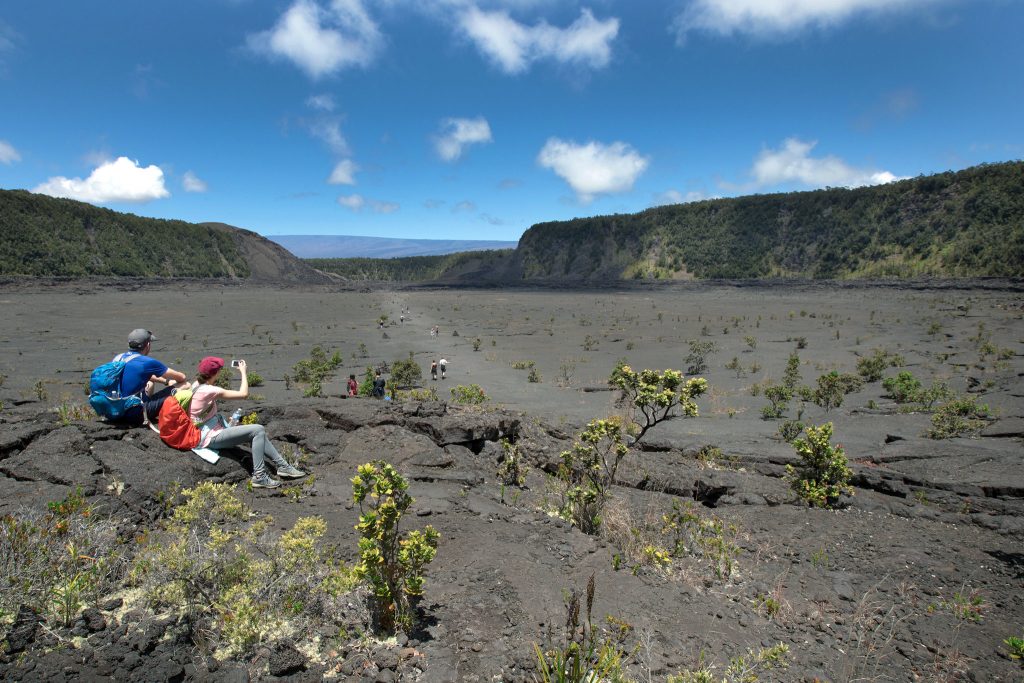One Year After Kīlauea Caldera’s Summit Collapses, Repair Efforts Continue
As the anniversary of the 2018 Kīlauea eruption nears, staff at Hawai‘i Volcanoes National Park continue efforts to repair and reopen trails and roads, assess and monitor unsafe areas, and welcome the public back to a landscape forever changed by last year’s epic volcanic activity.

Park managers to recap success and work ahead a year after Kīlauea caldera’s summit collapse. (April 2019) PC: HVNP
Members of the park’s management team will share successes and challenges on the “Road to Recovery: One Year Later,” a special After Dark in the Park presentation on Thursday, May 9 at 7 p.m. in the newly upgraded Kīlauea Visitor Center auditorium. The event is free, but park entrance fees apply.
The historic Kīlauea eruption and caldera collapse of 2018 resulted in most of the park closing for 134 days last year due to unsafe, unpredictable and unprecedented eruptive activity at the volcano’s summit. A hurricane, two tropical storms and a wildfire on Mauna Loa added to the intensity of an unforgettable year, but park rangers continued to serve the public at locations outside the park, protect natural and cultural resources, and expand hours at the park’s Kahuku Unit. Most of Hawai‘i Volcanoes is now open, including two-thirds of the popular Kīlauea Iki Trail, but some areas remain closed for safety.
“We invite our community to hear first-hand how we managed the extraordinary challenges this eruption created, and what we face moving ahead,” said Acting Superintendent Rhonda Loh. “The presentation will be about a half hour, and we welcome questions afterward,” Loh said.

Park managers to recap success and work ahead a year after Kīlauea caldera’s summit collapse. (April 2019) PC: HVNP
Until 2018, Kīlauea erupted almost nonstop from two locations within Hawai‘i Volcanoes National Park: from the remote Pu‘u ‘Ō‘ō vent in the East Rift Zone since 1983, and from its summit crater, Halema‘uma‘u, since 2008. Pu‘u ‘Ō‘ō was renowned for producing surface lava that periodically streamed into the ocean, while Halema‘uma‘u hosted a dazzling lake of lava for nearly 10 years with glowing lava often visible from vantage points along the caldera rim. Many native Hawaiians consider Halema‘uma‘u the home of Pele, the Hawaiian volcano deity, and the entire summit area is one of the most sacred areas in all of Hawai‘i.
On April 30, 2018, the floor of Pu‘u ‘Ō‘ō vent collapsed, followed by earthquakes (including a magnitude 6.9 on May 4) and movement of molten rock towards the lower Puna community.

Park managers to recap success and work ahead a year after Kīlauea caldera’s summit collapse. (April 2019) PC: HVNP
More than 700 homes were destroyed by lava, and more than 2,000 people were displaced. At the summit, lava disappeared from Halema‘uma‘u, and 60,000 or so earthquakes damaged park buildings, roads, trails, water systems and other infrastructure through the summer. Most of the park closed May 11, 2018 to Sept. 22, 2018. Currently, Kīlauea is not erupting, and there is no molten lava on the surface, but the volcano remains active and is closely monitored by scientists.













